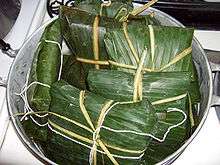Nacatamal

A nacatamal is a dish found in Honduras and Nicaragua similar to the tamal.[1][2][3][4] The nacatamal is perhaps the most produced within traditional Nicaraguan cuisine and it is an event often reserved for Sundays at mid-morning, it is usually eaten together with fresh bread and coffee. It is common to enjoy nacatamales (plural) during special occasions and to invite extended family and neighbors to partake.


Ingredients
A nacatamal is made up of mostly nixtamalized corn masa (a kind of dough traditionally made from a process called nizquezar) and lard, but includes seasonings such as salt and achiote (annatto). This combination is traditionally cooked in a large batch over a wood fire. The result becomes the base for the nacatamal and it is also referred to as masa. This base is ladled onto plantain leaves used for wrapping into large individual portions. The leaves undergo their own preparation separately. Before a nacatamal can be wrapped and brought to the last stage of the cooking process, it must be filled. The filling usually consists of annatto-seasoned pork meat, rice, slices of potatoes, bell peppers, tomatoes, and onions; olives, spearmint sprigs, and chile congo, a very small, egg-shaped chile found in Nicaragua. On occasion, prunes, raisins or capers can be added. The masa and filling are then wrapped in the plantain leaves, tied with a string, and made into pillow-shaped bundles - nacatamales. They are then steamed or pressure-cooked for several hours. The entire process is very labor-intensive and it often requires preparation over the course of two days; it may be necessary to involve the whole family to complete it.
Pindongo, no-chile option
Nacatamales can also be made pindongo (with no pork) for religious reasons like the Nicaraguan-Jewish community or with no chile, for people with sensitive stomachs.
Vegetarian option
Traditionally, nacatamales are not vegetarian, as they use lard in the masa, but as vegetarianism becomes more popular, it is certainly possible to make a vegetarian nacatamal. The process for it would be the same, except that the meat would be left out or could be substituted for another protein source such as tofu, seitan or chickpeas. Vegetable oil can be substituted for the lard.
See also
- List of maize dishes
-
 Food portal
Food portal